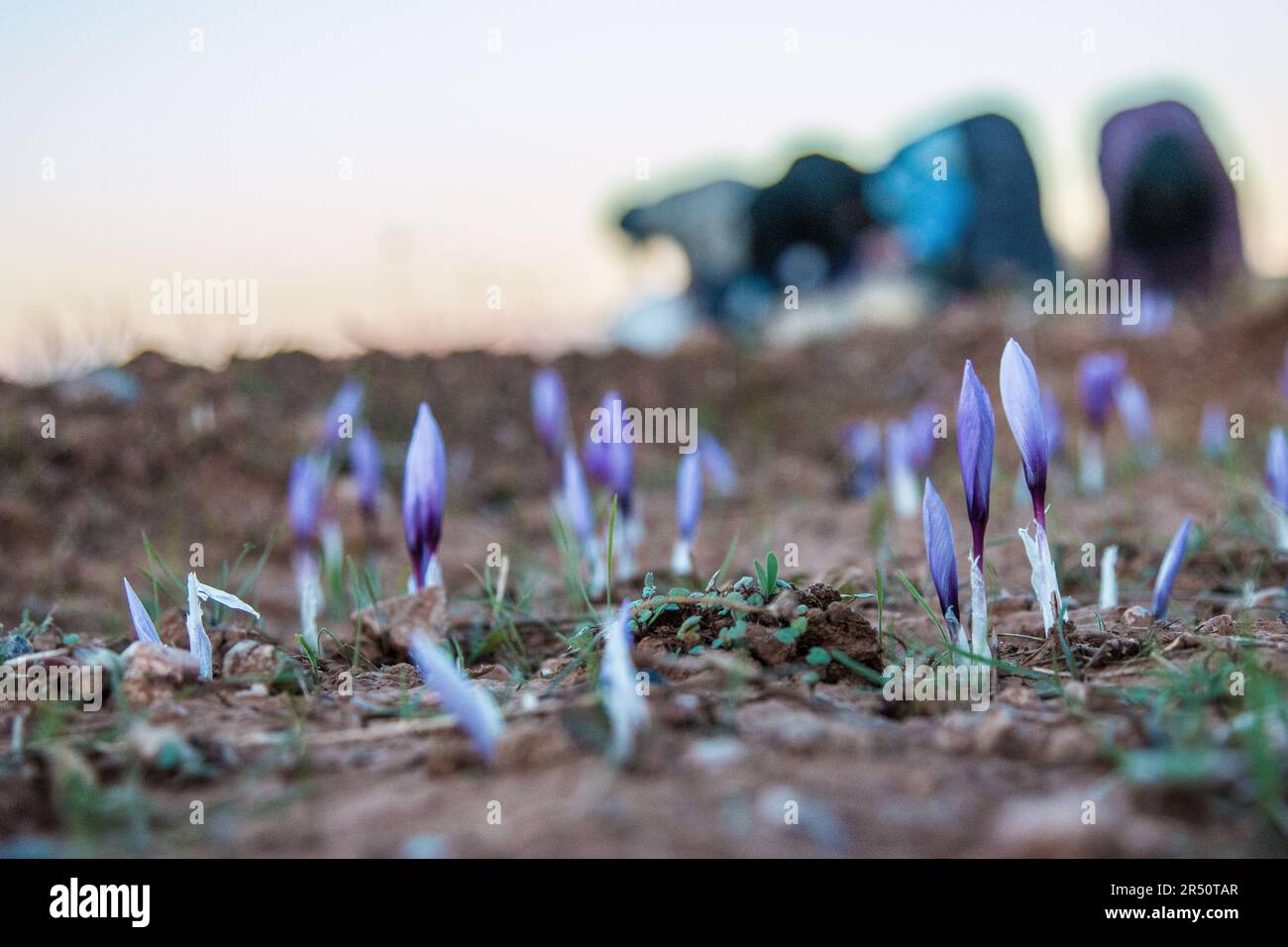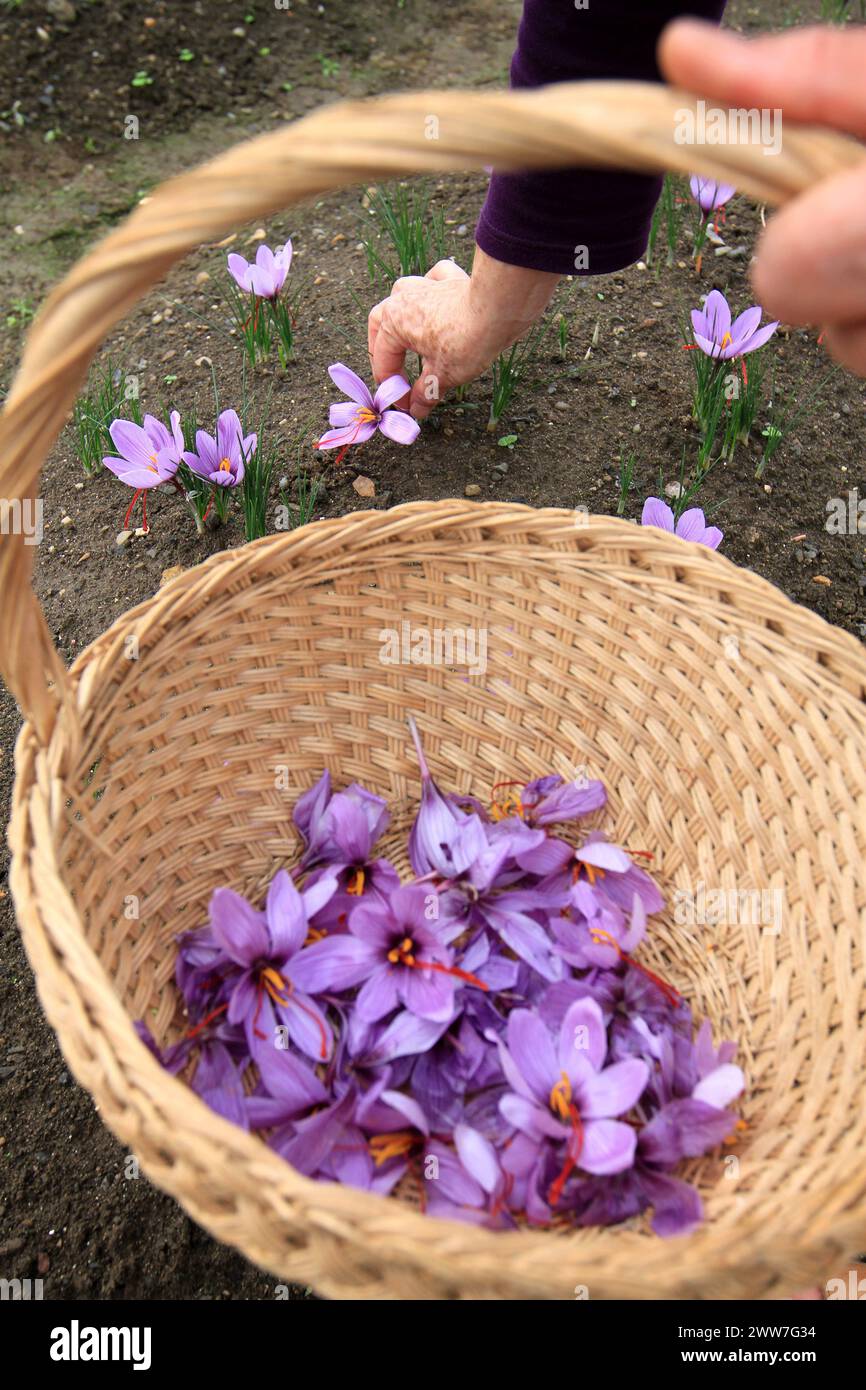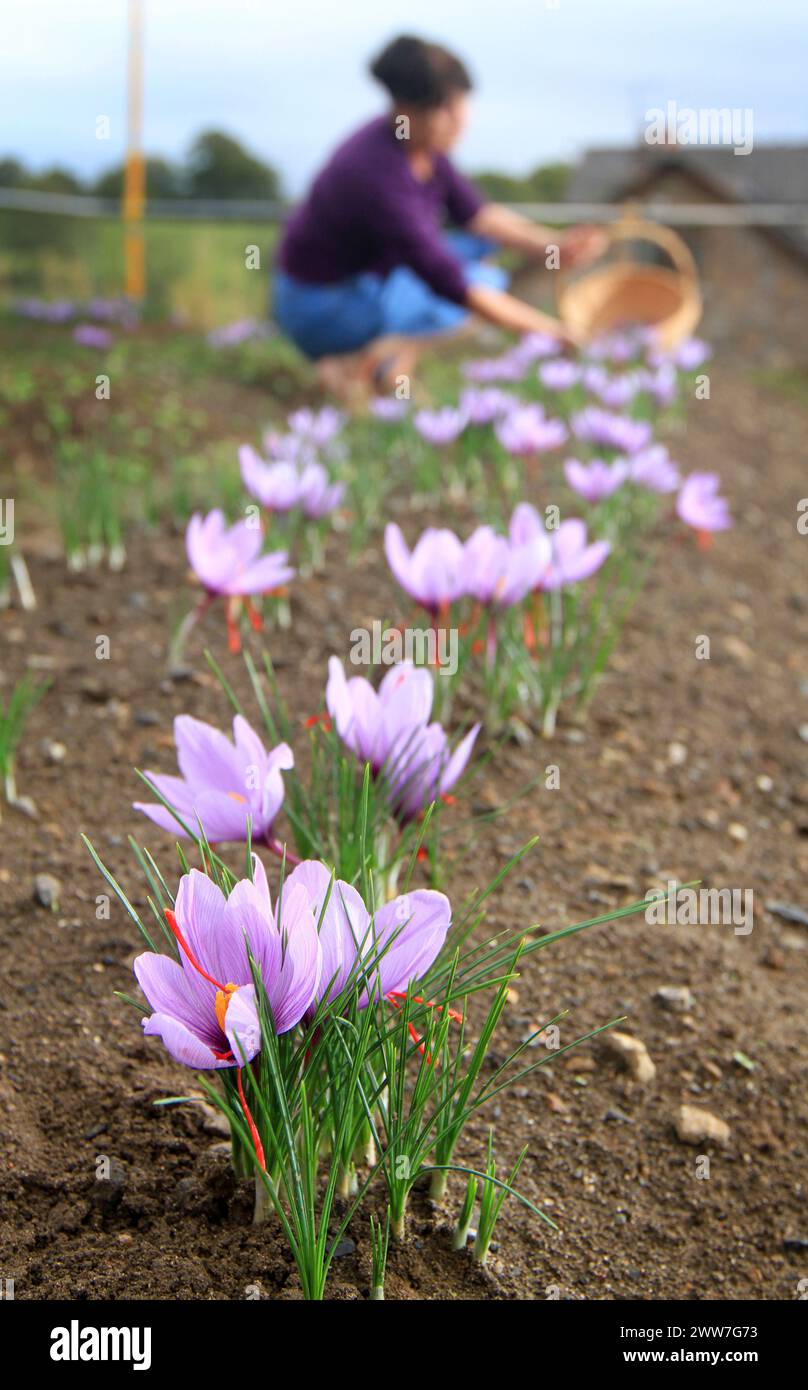Top-Rated Zaffronie Growers: Find The Best Near You
zaffronie growers are the backbone of the saffron industry, the world's most expensive spice.
Zaffronie growers are farmers who specialize in cultivating saffron crocuses, the flowers from which saffron is derived. Saffron is a highly prized spice that is used in cooking, medicine, and dyeing. It is known for its distinctive flavor, aroma, and deep red color.
Zaffronie growers typically work on small family farms. They must have a deep understanding of the saffron crocus and its cultivation requirements. Saffron crocuses are very delicate plants, and they require careful attention to detail in order to produce a high-quality crop.
- Tony Shaloub Emmywinning Actor Comedian
- American Horror Story Kate Mara Unforgettable Performances Amp Behindthescenes
The cultivation of saffron is a labor-intensive process. Saffron crocuses are typically planted in the fall, and they bloom in the spring. The flowers must be harvested by hand, and the stigmas, which are the only part of the flower that is used to produce saffron, must be carefully removed. Once the stigmas have been removed, they must be dried and processed in order to produce saffron.
Zaffronie growers play a vital role in the production of saffron. They are responsible for cultivating the saffron crocus, harvesting the flowers, and processing the stigmas to produce saffron. Saffron is a valuable spice that is used in a variety of applications, and zaffronie growers are essential to the production of this important crop.
zaffronie growers
Introduction: Saffron is the world's most expensive spice, and it is derived from the saffron crocus flower. Saffron crocuses are very delicate plants, and they require careful attention to detail in order to produce a high-quality crop.
Key Aspects:
- Cultivation: Saffron crocuses are typically planted in the fall, and they bloom in the spring. The flowers must be harvested by hand, and the stigmas, which are the only part of the flower that is used to produce saffron, must be carefully removed.
- Harvesting: Once the stigmas have been removed, they must be dried and processed in order to produce saffron.
- Processing: Saffron is a very labor-intensive spice to produce. It takes approximately 150,000 saffron crocus flowers to produce one pound of saffron.
Discussion: Saffron is used in a variety of applications, including cooking, medicine, and dyeing. It is known for its distinctive flavor, aroma, and deep red color.
{point}
Introduction: Zafferonie growers play a vital role in the production of saffron. They are responsible for cultivating the saffron crocus, harvesting the flowers, and processing the stigmas to produce saffron.
Facets:
- Economic Importance: Saffron is a valuable spice that is used in a variety of applications. It is estimated that the global saffron market is worth over $2 billion.
- Cultural Importance: Saffron has been used for centuries in cooking, medicine, and dyeing. It is an important part of many cultures around the world.
- Environmental Importance: Saffron crocuses are very delicate plants, and they require careful attention to detail in order to produce a high-quality crop. Saffron cultivation can help to promote biodiversity and protect the environment.
Summary: Saffron is a valuable spice that is used in a variety of applications. Saffron cultivation is a labor-intensive process, but it is an important part of many cultures around the world.
zaffronie growers
Zaffronie growers are the backbone of the saffron industry, responsible for cultivating the delicate saffron crocus and processing its stigmas to produce the world's most expensive spice. Their expertise and dedication are crucial to the production of this and versatile ingredient.
- Cultivation: Skilled in nurturing saffron crocuses, ensuring optimal growth and harvest.
- Harvesting: Meticulous and timely collection of saffron stigmas, preserving their quality and yield.
- Processing: Precise techniques to extract, dry, and prepare saffron stigmas, maximizing their flavor and aroma.
- Expertise: Deep understanding of saffron crocus cultivation, including soil preparation, irrigation, and pest management.
- Tradition: Preserving cultural practices and knowledge passed down through generations of zaffronie growers.
- Sustainability: Committed to environmentally friendly practices, ensuring the longevity of saffron cultivation and its benefits.
These key aspects highlight the multifaceted role of zaffronie growers. Their skills, knowledge, and dedication are essential to the production of high-quality saffron, a spice that has been treasured for centuries for its culinary, medicinal, and cultural significance. From the careful cultivation of saffron crocuses to the precise processing of its stigmas, zaffronie growers play a vital role in preserving and sharing this and versatile ingredient with the world.
Cultivation
Saffron crocuses are delicate plants that require specific conditions to thrive. Zaffronie growers possess the expertise and dedication to nurture these plants, ensuring optimal growth and a bountiful harvest. They understand the intricacies of soil preparation, irrigation, and pest management, creating an environment that fosters the saffron crocus's growth and development.
- Soil Preparation:
Zaffronie growers carefully prepare the soil to ensure proper drainage, pH level, and nutrient content. They use organic matter and natural fertilizers to enrich the soil, providing the saffron crocuses with the necessary nutrients for healthy growth.
- Irrigation:
Saffron crocuses require precise irrigation to prevent waterlogging or drought stress. Zaffronie growers monitor soil moisture levels and adjust watering schedules accordingly, ensuring the plants receive the optimal amount of water for their growth and development.
- Pest Management:
Zaffronie growers employ integrated pest management practices to protect saffron crocuses from pests and diseases. They use natural predators, organic pesticides, and crop rotation techniques to minimize the impact of pests and ensure the health of their crops.
- Harvesting:
Harvesting saffron stigmas is a delicate and time-sensitive process. Zaffronie growers carefully handpick the stigmas at the peak of their maturity, ensuring the highest quality and yield. They use precise techniques to extract the stigmas without damaging the flowers, preserving their flavor and aroma.
The cultivation practices employed by zaffronie growers are essential for the production of high-quality saffron. Their expertise and dedication ensure the optimal growth and harvest of saffron crocuses, resulting in the finest saffron stigmas that are prized by chefs, culinary enthusiasts, and medicinal practitioners around the world.
Harvesting
The meticulously timed harvest of saffron stigmas is a critical aspect for zaffronie growers, directly influencing the quality and yield of this precious spice. This delicate process requires expertise, precision, and an unwavering commitment to preserving the stigmas' unique characteristics and maximizing their value.
- Timing and Technique:
Zaffronie growers carefully monitor the development of saffron crocus flowers, waiting for the stigmas to reach their peak maturity. Once ready, the stigmas are meticulously handpicked at dawn or dusk to ensure optimal flavor and aroma. This precise timing and delicate technique help preserve the stigmas' delicate structure and prevent any loss of their precious compounds.
- Preserving Quality:
Zaffronie growers employ various techniques to preserve the quality of the harvested stigmas. They gently separate the stigmas from the rest of the flower, taking care not to damage their delicate structure. The stigmas are then carefully dried in a controlled environment to maintain their flavor, aroma, and color.
- Maximizing Yield:
Skilled zaffronie growers implement strategies to maximize the yield of saffron stigmas while maintaining their high quality. They carefully manage the timing of the harvest, ensuring that all mature stigmas are collected before they begin to wilt or deteriorate. Additionally, they employ sustainable cultivation practices to promote the health and productivity of their saffron crocus plants.
- Experience and Intuition:
Harvesting saffron stigmas is not merely a technical task but also an art that requires experience and intuition. Zaffronie growers develop a deep understanding of their crop's behavior, relying on their honed senses to determine the optimal time for harvesting and the best techniques to preserve the stigmas' quality. Their expertise ensures that the saffron they produce consistently meets the highest standards of excellence.
In conclusion, the meticulous and timely collection of saffron stigmas is a defining aspect of zaffronie growers' expertise. Through their dedication to preserving quality and maximizing yield, they play a vital role in bringing this rare and valuable spice to the world. Their skills and knowledge are essential for ensuring that saffron continues to be cherished by culinary enthusiasts, medicinal practitioners, and those who appreciate the finer things in life.
Processing
After the delicate harvest of saffron stigmas, zaffronie growers employ precise techniques to process the stigmas and prepare them for use. These techniques are essential for maximizing the flavor, aroma, and quality of saffron, ensuring that it meets the high standards demanded by discerning consumers worldwide.
- Extraction:
Once the stigmas are harvested, they are carefully separated from the rest of the flower. This process requires delicate handling to avoid damaging the delicate stigmas and compromising their quality.
- Drying:
The extracted stigmas are then dried to remove moisture and preserve their flavor and aroma. Zaffronie growers use traditional drying methods that involve exposing the stigmas to warm, dry air. This process must be carefully controlled to prevent over-drying, which can diminish the stigmas' quality.
- Roasting:
In some cases, saffron stigmas are roasted to enhance their flavor and aroma. This process is done over a low heat, and the stigmas are constantly monitored to ensure they do not burn. Roasting brings out the saffron's unique earthy and slightly smoky notes.
- Grinding:
Once the stigmas are dry, they can be ground into a powder. This powder is the form of saffron that is most commonly used in cooking. Grinding the saffron releases its flavor and aroma, allowing it to be easily incorporated into dishes.
The processing techniques employed by zaffronie growers are crucial for ensuring the quality and value of saffron. By carefully extracting, drying, and preparing the stigmas, they preserve the unique characteristics of this precious spice. Their expertise and dedication ensure that saffron continues to be a highly sought-after ingredient in culinary and medicinal applications around the world.
Expertise
Zaffronie growers possess a deep understanding of saffron crocus cultivation, including soil preparation, irrigation, and pest management. This expertise is crucial for the successful cultivation of saffron crocuses, which are delicate plants that require specific conditions to thrive. Zaffronie growers must have a thorough knowledge of the soil requirements, water needs, and pest vulnerabilities of saffron crocuses in order to create an environment that is conducive to their growth and development.
Soil preparation is essential for ensuring that saffron crocuses have the proper nutrients and drainage to flourish. Zaffronie growers carefully prepare the soil by adding organic matter and adjusting the pH level to meet the specific needs of saffron crocuses. They also implement irrigation systems that provide the plants with the right amount of water without overwatering or underwatering.
Pest management is another important aspect of saffron crocus cultivation. Zaffronie growers use a variety of methods to protect their crops from pests and diseases, including crop rotation, companion planting, and the use of natural pesticides. By employing these techniques, zaffronie growers can minimize the risk of crop damage and ensure a bountiful harvest of saffron stigmas.
The expertise of zaffronie growers in saffron crocus cultivation is essential for the production of high-quality saffron. Their deep understanding of the plant's needs and their ability to create an optimal growing environment ensure that saffron crocuses can thrive and produce the finest stigmas. This expertise is a key factor in the success of the saffron industry and contributes to the value and reputation of saffron as a precious spice.
Tradition
The tradition of saffron cultivation has been passed down through generations of zaffronie growers, embodying a wealth of cultural practices and knowledge that are essential for the production of high-quality saffron. This tradition includes a deep understanding of the specific soil, climate, and cultivation techniques required for saffron crocuses to thrive.
Zaffronie growers have a deep respect for the land and the environment, and their traditional practices reflect this. They often use organic farming methods to maintain the health of the soil and protect the delicate saffron crocus plants. They also rely on natural pest control methods, such as crop rotation and companion planting, to minimize the use of harmful chemicals.
The traditional knowledge of zaffronie growers also extends to the harvesting and processing of saffron stigmas. They have developed precise techniques for harvesting the stigmas at the peak of their maturity, and for drying and roasting them to preserve their flavor and aroma. These traditional methods have been passed down from generation to generation, ensuring that the unique qualities of saffron are preserved.
The tradition of saffron cultivation is not only a cultural heritage but also a vital part of the saffron industry. The knowledge and skills of zaffronie growers are essential for the production of high-quality saffron, which is prized by chefs, culinary enthusiasts, and medicinal practitioners around the world. By preserving these traditional practices, zaffronie growers are not only safeguarding a cultural heritage but also ensuring the continued availability of this precious spice.
Sustainability
Saffron cultivation is closely intertwined with sustainability, and zaffronie growers play a crucial role in ensuring the longevity of this precious crop and its benefits. Sustainable practices are essential for preserving the delicate ecosystem in which saffron crocuses thrive, safeguarding the environment, and ensuring the continued availability of high-quality saffron for generations to come.
Zaffronie growers implement various sustainable techniques to minimize their environmental impact. They often rely on organic farming methods, avoiding the use of harmful pesticides and fertilizers that can damage the soil and water sources. Crop rotation and companion planting are also employed to maintain soil health and reduce the risk of pests and diseases. Additionally, zaffronie growers conserve water resources by using efficient irrigation systems and mulching techniques.
By adopting sustainable practices, zaffronie growers not only protect the environment but also contribute to the long-term viability of saffron cultivation. Healthy soil, clean water, and a balanced ecosystem are essential for the production of high-quality saffron. Sustainable practices help to ensure that future generations of zaffronie growers can continue to cultivate this precious spice while preserving the delicate environment in which it grows.
Frequently Asked Questions about Saffron Cultivation
This section addresses common questions and misconceptions about saffron cultivation, providing informative answers based on the expertise of zaffronie growers.
Question 1: What are the challenges faced by zaffronie growers?
Zaffronie growers face several challenges, including the delicate nature of saffron crocus plants, which are susceptible to pests, diseases, and weather conditions. Additionally, the labor-intensive nature of saffron cultivation, from planting to harvesting and processing, requires significant time and effort. Saffron production is also influenced by environmental factors such as soil quality, water availability, and climate, which can impact crop yields and stigma quality.
Question 2: How can sustainability be incorporated into saffron cultivation practices?
Zaffronie growers prioritize sustainable practices to preserve the environment and ensure the longevity of saffron cultivation. They adopt organic farming methods, avoiding harmful pesticides and fertilizers, and utilize crop rotation and companion planting to promote soil health. Efficient irrigation systems and mulching techniques help conserve water resources. By embracing sustainability, zaffronie growers contribute to the preservation of ecosystems, ensuring the continued availability of high-quality saffron for future generations.
Summary: Saffron cultivation presents unique challenges, but zaffronie growers demonstrate resilience and expertise in overcoming them. Their commitment to sustainable practices ensures the preservation of the environment and the longevity of saffron production, benefiting both the industry and consumers.
Conclusion
Saffron cultivation is a complex and delicate process that requires expertise, dedication, and a deep understanding of the unique needs of saffron crocuses. Zaffronie growers play a vital role in this process, nurturing the plants, harvesting the stigmas, and processing them into the precious spice that is saffron.
The expertise of zaffronie growers extends beyond cultivation techniques. They are also the guardians of traditional practices and knowledge that have been passed down through generations. These traditions not only ensure the quality of saffron but also contribute to the cultural heritage of the regions where it is grown.
In recent years, there has been a growing emphasis on sustainability in saffron cultivation. Zaffronie growers are at the forefront of this movement, adopting organic farming methods and implementing water conservation techniques. By doing so, they are not only preserving the environment but also ensuring the long-term viability of saffron cultivation.
Saffron is a precious spice that is prized for its flavor, aroma, and medicinal properties. The dedication of zaffronie growers is essential for bringing this spice to our tables and pharmacies. Their expertise, traditions, and commitment to sustainability ensure that saffron will continue to be a cherished part of our culinary and medicinal traditions for generations to come.
- Beyond The Royal Tenenbaums A Timeless Masterpiece
- Movierulz New Movies Your Ultimate Guide To Streaming Blockbusters

Female Saffron Growers Picking Flowers Early in the Morning in

13/10/11 ..Caroline Riden harvests saffron...One of Britain’s only

13/10/11 ..Caroline Riden harvests saffron...One of Britain’s only